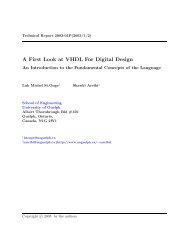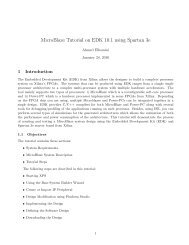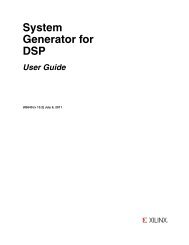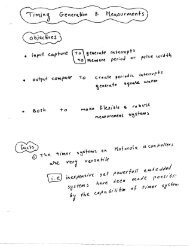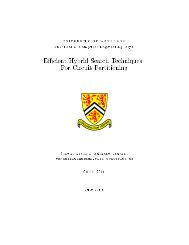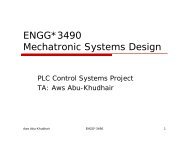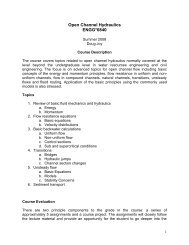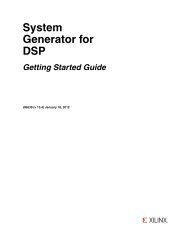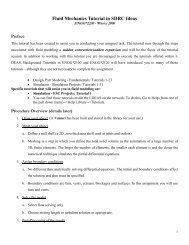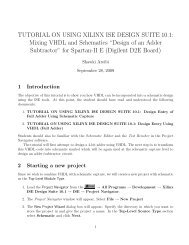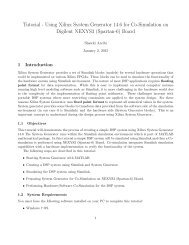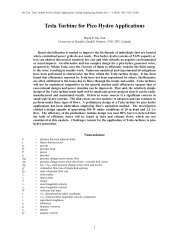The Stack, Subroutines, Interrupts, and Resets: Ch3 Spasov
The Stack, Subroutines, Interrupts, and Resets: Ch3 Spasov
The Stack, Subroutines, Interrupts, and Resets: Ch3 Spasov
You also want an ePaper? Increase the reach of your titles
YUMPU automatically turns print PDFs into web optimized ePapers that Google loves.
<strong>The</strong> <strong>Stack</strong>, <strong>Subroutines</strong>,<br />
<strong>Interrupts</strong>, <strong>and</strong> <strong>Resets</strong>:<br />
<strong>Ch3</strong> <strong>Spasov</strong><br />
A. <strong>The</strong> stack<br />
B. <strong>Subroutines</strong><br />
C. <strong>Interrupts</strong><br />
D. <strong>Resets</strong><br />
<strong>The</strong><br />
STACK<br />
ENGG4640/3640; Fall 2004; Prepared by Radu Muresan 1<br />
<strong>The</strong> stack is a special area in memory used by the CPU to store<br />
register information or general data information during program<br />
execution<br />
<strong>The</strong> stack has a top <strong>and</strong> a bottom<br />
<strong>The</strong> SP register is the special register that controls the address<br />
in the stack<br />
<strong>The</strong> stack used is a LIFO structure that uses push <strong>and</strong> pull<br />
(pop) operations<br />
ENGG4640/3640; Fall 2004; Prepared by Radu Muresan 2
Using the<br />
STACK<br />
push operations:<br />
PSHA, PSHB, PSHX, <strong>and</strong> PSHY<br />
pull operations<br />
PULA, PULB, PULX, <strong>and</strong> PULY<br />
Sometimes we push the register data onto the stack when we<br />
need to load the registers with other values to perform certain<br />
operations ...<br />
ENGG4640/3640; Fall 2004; Prepared by Radu Muresan 3<br />
<strong>Stack</strong> as a Storage Buffer<br />
* Listing 3.1<br />
* SUM OF SQUARES<br />
* Demonstrate push <strong>and</strong> pull operations<br />
* Program calculates x squared plus y squared.<br />
* It gets x <strong>and</strong> y as 8-bit numbers from addresses<br />
* $1031 <strong>and</strong> $1032.<br />
* It puts the 8-bit result in ACCA.<br />
ORG $E000 ;start address of program<br />
BEGIN LDS #$FF ;You must define the stack first<br />
LDAA $1031 ;Get first data, x<br />
TAB ;<strong>and</strong> square it<br />
MUL<br />
ADCA #$00 ;round it to 8-bit result<br />
PSHA ;<strong>and</strong> save it<br />
LDAA $1032 ;Get second data, y<br />
TAB<br />
MUL<br />
;<strong>and</strong> square it<br />
ADCA #$00 ;round it to 8-bit result<br />
PULB ;retrieve first result<br />
ABA ;<strong>and</strong> add them<br />
HERE BRA HERE ;For now, stop program<br />
ENGG4640/3640; Fall 2004; Prepared by Radu Muresan 4
Using <strong>Subroutines</strong><br />
A subroutine allows us to reuse code. It is a section of<br />
a program that may be used one or more times<br />
<strong>The</strong> main program calls subroutines to perform<br />
certain steps<br />
A data input/output process for subroutines is called<br />
parameter passing<br />
If there are not enough registers for parameter passing, a<br />
calling program can pass more parameters using stack<br />
Ex: Modify the program from the previous slide to add<br />
many squares<br />
Subroutine Example<br />
ENGG4640/3640; Fall 2004; Prepared by Radu Muresan 5<br />
* SUM OF SQUARES: Demonstrate subroutines<br />
* Program squares all the numbers in addresses $C000 to $C07F<br />
* <strong>and</strong> puts the sum of the squares as a 16-bit result in IX.<br />
ORG $E000 ;start address<br />
* Start MAIN<br />
MAIN LDS #$CFFF ;You must define<br />
* ;the stack first squaring loop<br />
LDX #$C000 ;init. data block pointer<br />
LOOP1<br />
JSR SQUARE ;square it <strong>and</strong> point to next data<br />
PSHA ;save square<br />
CPX #$C080 ;squared all data?<br />
BNE LOOP1 ;get more if not<br />
* ;summing loop<br />
LDX #$0000 ;sum = 0<br />
LDAA #$80 ;i=$80<br />
LOOP2 PULB ;get square(i)<br />
ABX ;sum = sum + square(i)<br />
DECA ;i=i-1<br />
BNE LOOP2 ;repeat until i == 0<br />
HERE BRA HERE ;stop program<br />
* End of MAIN<br />
* ----------------------------------------------------<br />
ENGG4640/3640; Fall 2004; Prepared by Radu Muresan 6
Subroutine Example<br />
* SUBROUTINE SQUARE<br />
* calculates the square of an 8-bit number<br />
* as a rounded 8-bit normalized result<br />
* data pointer (IX) increments<br />
* calling registers:<br />
* IX = address of data to be squared<br />
* return registers:<br />
* ACCA = 8-bit square<br />
* IX=IX+1<br />
* ACCB is affected<br />
* others unaffected<br />
SQUARE<br />
LDAA $0,X<br />
TAB<br />
MUL<br />
ADCA #$00 ;round it to 8-bit result<br />
INX<br />
RTS<br />
ENGG4640/3640; Fall 2004; Prepared by Radu Muresan 7<br />
* -----------------------------------------------------<br />
Process of Calling <strong>Subroutines</strong><br />
ENGG4640/3640; Fall 2004; Prepared by Radu Muresan 8
Example: Subroutine Using the <strong>Stack</strong><br />
* Listing 3.6<br />
* Demonstrate a convention for using subroutines<br />
* using a modification of Subroutine SQUARE<br />
* (See Listing 3.2). Program squares all the numbers<br />
* in addresses $C000 to $C07F<br />
ORG $E000 ;start address<br />
* Start MAIN<br />
MAIN LDS #$FF ;You must define the stack first<br />
* ;squaring loop<br />
LDX #$C000 ;init. data block pointer<br />
* ;IX is the calling register<br />
LOOP1<br />
JSR SQUARE2 ;square it <strong>and</strong> note that<br />
* ;original IX value returned<br />
INX ;point to next data<br />
CPX #$C080 ;squared all data?<br />
BNE LOOP1 ;get more if not<br />
HERE<br />
* End of MAIN<br />
BRA HERE ;stop program<br />
ENGG4640/3640; Fall 2004; Prepared by Radu Muresan 9<br />
Example: Subroutine Using the <strong>Stack</strong><br />
* SUBROUTINE SQUARE2<br />
* calculates the square of an 8-bit number as a rounded 8-bit result<br />
* data pointer (IX) increments<br />
* calling registers:IX = address of data to be squared<br />
* return registers: IX = address of 8-bit square<br />
* CCR affected; others unaffected<br />
SQUARE2<br />
PSHA ;preserve registers<br />
PSHB<br />
* ;note that following instructions modify<br />
* ;ACCA <strong>and</strong> ACCB<br />
LDAA $0,X ;get data to square<br />
TAB ;copy it to ACCB<br />
MUL ;square it<br />
ADCA #$00 ;round it to 8-bit result<br />
STAA $0,X ;store result<br />
PULB ;restore registers<br />
PULA<br />
RTS ;return, note that ACCA <strong>and</strong> ACCB<br />
* ;contain their original values<br />
ENGG4640/3640; Fall 2004; Prepared by Radu Muresan 10
Example: Subroutine Using the <strong>Stack</strong><br />
<strong>The</strong> number of pushes must be equal with the number of pulls<br />
ENGG4640/3640; Fall 2004; Prepared by Radu Muresan 11<br />
ENGG4640/3640; Fall 2004; Prepared by Radu Muresan 12
ENGG4640/3640; Fall 2004; Prepared by Radu Muresan 13<br />
ENGG4640/3640; Fall 2004; Prepared by Radu Muresan 14
ENGG4640/3640; Fall 2004; Prepared by Radu Muresan 15<br />
Typical Program Execution<br />
Without interrupts the program executes continuously<br />
ENGG4640/3640; Fall 2004; Prepared by Radu Muresan 16
<strong>Resets</strong><br />
A reset is a special type of interrupt<br />
Unlike an interrupt, it does not return to the interrupted<br />
program<br />
A reset stops execution of the application program to do a<br />
special function, such as reinitializing the registers <strong>and</strong><br />
memory<br />
<strong>Resets</strong><br />
<strong>and</strong><br />
<strong>Interrupts</strong><br />
ENGG4640/3640; Fall 2004; Prepared by Radu Muresan 17<br />
ENGG4640/3640; Fall 2004; Prepared by Radu Muresan 18
<strong>The</strong> 68HC11 has four possible types of<br />
reset<br />
External RESET^ pin<br />
Power-on reset (POR)<br />
Computer operating<br />
properly (COP)<br />
Clock monitor reset<br />
Types 1 <strong>and</strong> 2 are external resets<br />
<strong>and</strong> types 3 <strong>and</strong> 4 are fault<br />
tolerant resets or internal resets.<br />
Other differences between resets <strong>and</strong> interrupts are:<br />
•Reset exception is immediately recognized asynchronously<br />
to the clock<br />
•MCU stays in the reset state as long as reset signal is active<br />
•An interrupt is only sampled by the CPU at the end of instr. seq.<br />
Interrupt<br />
External<br />
RESET<br />
Q: How does MCU knows<br />
the source of RESET?<br />
ENGG4640/3640; Fall 2004; Prepared by Radu Muresan 19<br />
An interrupt suspends the execution of an application to<br />
do something else – it is triggered by an interrupt request<br />
An interrupt service routine (ISR) is initiated<br />
RTI instruction has to be at the end of the ISR to load registers<br />
ENGG4640/3640; Fall 2004; Prepared by Radu Muresan 20
Interrupt Vector<br />
All resets <strong>and</strong> interrupts<br />
use vectors<br />
A vector indicates the<br />
start address of reset or<br />
interrupt routines<br />
A vector address is a 2byte<br />
memory location<br />
that stores a vector<br />
Typical Motorola<br />
processors use a single<br />
area of memory to store<br />
the vectors => known as<br />
the vector table<br />
We can divide the<br />
interrupt sources into<br />
four groups:<br />
interrupts from on-chip<br />
resources<br />
external interrupts<br />
software interrupts<br />
<strong>and</strong> reset exceptions<br />
ENGG4640/3640; Fall 2004; Prepared by Radu Muresan 21<br />
ENGG4640/3640; Fall 2004; Prepared by Radu Muresan 22
CPU Interrupt<br />
Processing<br />
<strong>The</strong> interrupt process<br />
consists of hardware that<br />
detects an event <strong>and</strong> signals<br />
the CPU<br />
<strong>The</strong> CPU changes the<br />
program flow to the Interrupt<br />
Service Routine<br />
<strong>The</strong> process in the side<br />
diagram is called exception<br />
processing because the CPU<br />
will execute the next<br />
instruction except when one<br />
of the interrupts is pending<br />
An interrupt is said to be<br />
pending when it is enabled,<br />
its event has been detected,<br />
<strong>and</strong> it has not been serviced<br />
ENGG4640/3640; Fall 2004; Prepared by Radu Muresan 23<br />
Pending Interrupt Detection<br />
Most interrupts are detected by the on-chip resource<br />
Only IRQ <strong>and</strong> XIRQ are detected directly by the CPU<br />
<strong>The</strong> CPU checks the interrupt signals from all sources<br />
after it had finished executing each instruction<br />
<strong>The</strong> interrupt signals from on-chip resources are<br />
implemented either as event flags that must be<br />
cleared explicitly or as automatic event flags<br />
IRQ <strong>and</strong> XIRQ are active-low signals, so these<br />
sources are serviced as long as the interrupt signal is<br />
low<br />
ENGG4640/3640; Fall 2004; Prepared by Radu Muresan 24
Saving Context<br />
Once a pending interrupt is<br />
detected, CPU11, 12 saves<br />
the context by pushing all the<br />
CPU registers onto the stack<br />
All registers must be saved<br />
because the interrupt is<br />
asynchronous to the<br />
program flow <strong>and</strong> we cannot<br />
predict when it will occur<br />
At the end of ISR the RTI<br />
instruction restores the<br />
context of the interrupted<br />
program<br />
Set Interrupt Masks<br />
ENGG4640/3640; Fall 2004; Prepared by Radu Muresan 25<br />
After context save, CPU sets the appropriate<br />
masks<br />
if the interrupt source is one controlled by the I<br />
mask, then I will be set automatically<br />
if the interrupt source is the XIRQ, then both X <strong>and</strong><br />
I masks are set<br />
This is done to prevent nested interrupts<br />
before the system is ready<br />
ENGG4640/3640; Fall 2004; Prepared by Radu Muresan 26
Vectors<br />
Next step is to get the interrupt service routine<br />
An interrupt vector is two fixed memory locations that<br />
contain the address of the ISR for a given interrupt<br />
<strong>The</strong> CPU 11 interrupt vectors are stored at addresses<br />
shown in slide 22<br />
So, for example, to load the interrupt vector for a<br />
service routine you could do:<br />
ORG $vector<br />
FDB ISRname ; form double byte<br />
ENGG4640/3640; Fall 2004; Prepared by Radu Muresan 27<br />
Multiple <strong>Interrupts</strong> <strong>and</strong> Priority<br />
When a system has more<br />
than one interrupt source<br />
enabled, it must be able to<br />
h<strong>and</strong>le the condition when<br />
more than one interrupt is<br />
pending at the same time<br />
Since the CPU can only<br />
h<strong>and</strong>le a single interrupt at a<br />
time, a priority is assigned to<br />
each source<br />
<strong>The</strong> CPU then services the<br />
highest priority pending<br />
interrupt first<br />
If the ISR does not reset the<br />
I bit, only nonmaskable<br />
interrupts or resets can<br />
interrupt this service routine<br />
<strong>The</strong> ISR could clear I bit to<br />
allow itself to be interrupted<br />
Execution of the RTI restores<br />
the original condition of the I<br />
bit then the lower-priority<br />
interrupt can be serviced<br />
ENGG4640/3640; Fall 2004; Prepared by Radu Muresan 28
Software <strong>Interrupts</strong><br />
A software interrupt is an<br />
instruction that initiates the<br />
interrupt process<br />
In the CPU11 <strong>and</strong> CPU12<br />
the software interrupt<br />
instruction is SWI<br />
Software interrupts should<br />
be used exclusively for<br />
debugging tools such as<br />
software breakpoints in<br />
debug monitors <strong>and</strong><br />
emulators<br />
SWI is a single byte opcode<br />
instruction<br />
When a breakpoint is<br />
reached in a debug monitor<br />
the monitor program<br />
substitutes the instruction at<br />
that address with an SWI<br />
When the monitor is finished<br />
the SWI opcode is replaced<br />
with the original opcode<br />
Another use for SWI is as a<br />
subroutine that preserves the<br />
registers automatically<br />
ENGG4640/3640; Fall 2004; Prepared by Radu Muresan 29<br />
ENGG4640/3640; Fall 2004; Prepared by Radu Muresan 30
Software <strong>Interrupts</strong><br />
Another instructions that are used in the<br />
interrupt process are WRI <strong>and</strong> STOP<br />
<strong>The</strong>se instructions are useful when the<br />
program can be in a wait mode while waiting<br />
for an interrupt<br />
in the wait mode the 68HC11 can reduce its power<br />
consumption<br />
ENGG4640/3640; Fall 2004; Prepared by Radu Muresan 31<br />
ENGG4640/3640; Fall 2004; Prepared by Radu Muresan 32
ENGG4640/3640; Fall 2004; Prepared by Radu Muresan 33<br />
ENGG4640/3640; Fall 2004; Prepared by Radu Muresan 34
* PIOC configured as shown in Figure 9.13<br />
* <strong>and</strong> all other required initialization has been done.<br />
ORG $100<br />
LDY #PTR ;initialize data pointer<br />
CLI ;enable interrupts<br />
REPEAT<br />
WAI ;wait for falling STRA<br />
* ;to cause interrupt<br />
LDAA 0,Y ;send out data when it occurs<br />
STAA PORTB,X<br />
* ;note, MCU also pulses STRB low for 2 E-cycles<br />
INY ;repeat for next data transfer<br />
BRA REPEAT<br />
RIRQ<br />
* This is the interrupt h<strong>and</strong>ler routine for parallel I/O<br />
* Note it has the same vector ($FFF2,F3) as IRQ<br />
LDAA PIOC,X ;these two instructions clear STAF<br />
LDAA PORTCL,X<br />
RTI<br />
PTR EQU $180<br />
ENGG4640/3640; Fall 2004; Prepared by Radu Muresan 35<br />
ENGG4640/3640; Fall 2004; Prepared by Radu Muresan 36
STOP<br />
Instruction<br />
ENGG4640/3640; Fall 2004; Prepared by Radu Muresan 37<br />
ENGG4640/3640; Fall 2004; Prepared by Radu Muresan 38
St<strong>and</strong>ard<br />
Definitions<br />
External <strong>Interrupts</strong><br />
<strong>The</strong>re are 2 external interrupt<br />
pins on the CPU11 <strong>and</strong> 12<br />
IRQ – is an active-low,<br />
maskable interrupt signal<br />
request<br />
XIRQ – is an active-low,<br />
pseudo-nonmaskable<br />
interrupt request<br />
By default, when you power<br />
up the MPU or RESET it,<br />
XIRQ is masked, that is:<br />
<strong>The</strong> X bit in CCR is set<br />
ENGG4640/3640; Fall 2004; Prepared by Radu Muresan 39<br />
To unmask XIRQ, you use<br />
the TAP instruction to clear<br />
bit X<br />
Once the program has<br />
cleared it, executing another<br />
TAP will not set X again<br />
<strong>The</strong> only way to set X is to<br />
RESET the 68HX11<br />
TPA ;CCR -> A<br />
ANDA #$BF; reset bit 6 (X)<br />
TAP ;A -> CCR<br />
ENGG4640/3640; Fall 2004; Prepared by Radu Muresan 40
68HC11<br />
<strong>Interrupts</strong><br />
ENGG4640/3640; Fall 2004; Prepared by Radu Muresan 41<br />
ENGG4640/3640; Fall 2004; Prepared by Radu Muresan 42
Changing Priority<br />
HPRIO – highest priority<br />
interrupt register<br />
may be read at any time<br />
but may only be written<br />
under special<br />
circumstances<br />
interrupts obey a fixed<br />
hardware-priority circuit to<br />
resolve simultaneous<br />
requests<br />
However, an I-bit-related<br />
interrupt source may be<br />
elevated to the highest I-bit<br />
priority position in the<br />
resolution circuit<br />
<strong>The</strong> first six interrupts are not<br />
masked by the I bit in the<br />
CCR <strong>and</strong> have a fixed<br />
priority:<br />
reset, clock monitor fail,<br />
COP fail, illegal opcode<br />
<strong>and</strong> XIRQ<br />
HPRIO may only be written<br />
while the I-bit related<br />
interrupts are inhibited (I=1)<br />
ENGG4640/3640; Fall 2004; Prepared by Radu Muresan 43<br />
ENGG4640/3640; Fall 2004; Prepared by Radu Muresan 44
External<br />
Interrupt<br />
Design<br />
Approach<br />
ENGG4640/3640; Fall 2004; Prepared by Radu Muresan 45<br />
ENGG4640/3640; Fall 2004; Prepared by Radu Muresan 46
ENGG4640/3640; Fall 2004; Prepared by Radu Muresan 47<br />
ENGG4640/3640; Fall 2004; Prepared by Radu Muresan 48
How to<br />
Establish<br />
the<br />
Vector<br />
ENGG4640/3640; Fall 2004; Prepared by Radu Muresan 49<br />
ENGG4640/3640; Fall 2004; Prepared by Radu Muresan 50
IRQ Interrupt Request<br />
Interrupt<br />
Polling<br />
Using<br />
Linked<br />
Lists<br />
ENGG4640/3640; Fall 2004; Prepared by Radu Muresan 51<br />
ENGG4640/3640; Fall 2004; Prepared by Radu Muresan 52
6811 Assembly Structure for Interrupt<br />
Polling using Linked Lists<br />
ENGG4640/3640; Fall 2004; Prepared by Radu Muresan 53<br />
ENGG4640/3640; Fall 2004; Prepared by Radu Muresan 54
Periodic<br />
Polling<br />
Plus<br />
Real<br />
Time <strong>Interrupts</strong><br />
ENGG4640/3640; Fall 2004; Prepared by Radu Muresan 55<br />
ENGG4640/3640; Fall 2004; Prepared by Radu Muresan 56
6811 Registers<br />
Used to<br />
Configure the<br />
RTI<br />
ENGG4640/3640; Fall 2004; Prepared by Radu Muresan 57<br />
ENGG4640/3640; Fall 2004; Prepared by Radu Muresan 58
68HC11 Assembly Language Implementation of a Periodic Interrupt<br />
Using RTI<br />
ENGG4640/3640; Fall 2004; Prepared by Radu Muresan 59<br />
ENGG4640/3640; Fall 2004; Prepared by Radu Muresan 60
ENGG4640/3640; Fall 2004; Prepared by Radu Muresan 61<br />
ENGG4640/3640; Fall 2004; Prepared by Radu Muresan 62



